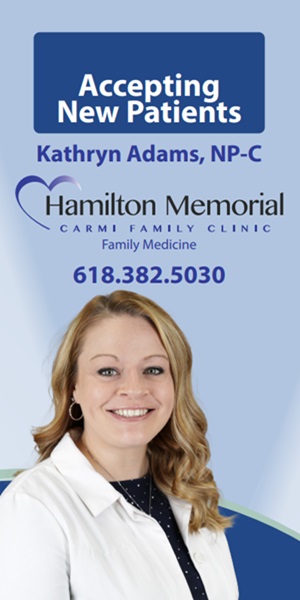Drones, or unmanned aircraft systems (UAS), are already making soaring strides in a number of industries, and none less vital to Southern Illinois than agriculture.
Of the dozen graduates in Rend Lake College’s first UAS program, two standouts are taking their lessons to the farm with a practical approach. Both alums are employed in the agriculture field, and after working hard to study for their pilot certification, both plan to explore the limitless possibilities this new technology will provide.
Jody Braden, a crop adjuster from McLeansboro, said the program was recommended to her by her employer because of the opportunities a UAS can offer. As an adjuster, Braden travels to farms and other agricultural properties to valuate claims for an insurance company.
“[Certification] is going to be useful as drones are up and coming. It’s beneficial to me and my company to have this under my belt,” said Braden. “It’s such a better view from the air. You can see hail damage, wind damage, chemical overspray, bug problems, drought damage, or anything else. Instead of having to walk, you can fly over and cover the field more accurately to see where the problems are. The difference is walking four fields a day to flying over 20 fields in a day.”
Not only will the drone assist Braden with her productivity on the job, it will also help the farmer by default.
“Covering more land accurately is as beneficial for us and the farmer. We may not be as accurate on foot as we can be with a drone. We may not see all of the damage. It saves so much time and correct information helps with insurance claims,” explained Braden. “If we can cover the field better in a half or a quarter of the time, it’s much better time spent.”
Don Bigham, LEFT, of Mt. Vernon controls a UAS last month during RLC’s class at the Rend Lake Resort in preparation to pass the pilot examination. Volunteer instructor Marty Cox, CENTER, provides feedback as Bigham’s classmate Eric Knapp, RIGHT, of Tamaroa serves as the watcher. Click on the image for a larger view.
(ReAnne Palmer / RLC Public Information)
Working for Country Financial, Braden had no prior experience with UASs before registering for RLC’s program last spring. When the Federal Aviation Administration (FAA) UAS pilot certification becomes available at the end of August, Braden said she plans to sit for the exam and begin using a UAS at work.
“I came in not knowing anything about drones. There are many rules and regulations that I can see where there are problems and why people can get in trouble. The program was a big eye-opener,” said Braden. “I think it was a very well taught program and Mr. Edwards approached it, added to it, and did a really good job. He has a great passion for drones and for teaching. I would recommend this program to anyone who is interested in flying a drone.”
Fellow classmate Jake Carter had similar sentiments and encouraged farmers and other agriculturists to see the “endless possibilities” a UAS can provide.
“It really is a great tool to have. Farming is a big deal, and the technology of a drone can really help a farmer save a little time and money,” said Carter, who grew up on his family’s farm in Missouri and continues to farm with his fiancé’s family in Waltonville. “It really will make the future of agriculture, and a lot of other industries, improve. There are endless possibilities; to do anything you want with it as long as you follow the rules.”
Like Braden, Carter said he plans to sit for the pilot certification next month so he can use it on the farm in a variety of ways. He is also keeping open the option to use it as a part-time job commercially.
“The program taught me about the different drone functions and what people can use it for. Drones will save some time, and I know it sounds a little lazy, but I can just set it off over the cattle and row crops, and I don’t have to get up. It’s a better view and takes less time to see everything,” explained Carter.
He continued, “We have cattle and can’t always get a good count on foot or horseback. With a drone, we can count how many we have from the air. If we can’t find a calf, we’ll use the drone to go out in the woods and see if we can find it. We also have row crops, so we can use it to go out and see what the crops look like, what stages they’re in, see if something is eating it or if there is any damage. It’s unlimited what you can do with it.”
Knapp hoovers the UAS over the landing pad during flight practice at the Rend Lake Resort. In the final course of RLC’s program, students take turns flying in preparation for the FAA certification exam, which will be available at the end of August. Click on the image for a larger view.
(ReAnne Palmer / RLC Public Information)
In the future, Carter says he only sees improvements made on current technology that will help people in a variety of areas. Specifically, he is interested in unique lenses that recognize heat patterns and nitrogen levels.
“I’m sure farmers are already using drones. The batteries last about 30 minutes, and you can check quite a few fields in that time. This technology will transform a lot of areas in the workforces in the future, it’s unbelievable,” said Carter. “I’d like to get into it with my certification. It will open a lot of doors.”
Fall 2016 Semester at RLC
UASs are a growing, cutting-edge technology with applications in a wide range of occupations other than agriculture, including business operations and programming, the collection and analysis of geospatial data, and much more. The use of UASs provides students access to relevant, real-time data and valuable experience.
Those interested in the UAS program can enroll now in Fall 2016 classes. The three required courses run one after another in one semester, lasting approximately five weeks each. This fall, classes are scheduled for 5 – 9:50 p.m. Mondays and Thursdays in the Advanced Technology Center, Room 177, on the Ina campus.
Introduction to Unmanned Aircraft Systems (UAS 1200) will meet first from Aug. 1 through Sept. 13. This course will cover many facets of UAS systems, including an examination of safety procedures, human factors, payloads, and information gathering. This course also incorporates flight simulations and live flying exercises.
The Advanced Unmanned Aircraft Systems (UAS 1201) class will follow from Sept. 20 through Nov. 10. An in-depth look at programming and flying UASs will take place over these five weeks with a special look at the selection and operation of sensors, and post-processing and analysis of data.
The final class, Unmanned Aircraft Law and Test Prep (UAS 1202), will meet for four weeks from Nov. 15 through Dec. 15. This course will examine current FAA guidelines on the flight of a UAS system in U.S. airspace. It will also cover all applicable state and federal laws, plus serve as the test prep portion to study the FAA material to pass the UAS Certification Exam.
After successful completion of these classes, graduates will have an occupational certificate, which can be used in a range of industries that continues to grow as the technology develops. To enroll, students must pass a criminal background check.
To become a certified pilot with the FAA, students must be 16 years of age, pass an aeronautical knowledge test, be vetted by the Transportation Security Administration, and be in a physical and mental condition to safely operation a UAS. More information about UASs can be found on the FAA’s website www.faa.gov/uas.
For more information about RLC’s UAS program, contact Chris Edwards at 618-437-5321, Ext. 1278 or [email protected].














